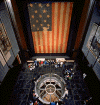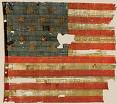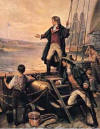| American Songbook |
 Star-Spangled
Banner Flag Star-Spangled
Banner Flag
National Museum of American History |
 |
| #3 "Star-Spangled Banner"
NATIONAL ANTHEM |
Original music by J. S. Smith; lyrics / poem by Francis
Scott Key 1814 |
 Star-Spangled
Banner Flag: New Exhibit at Smithsonian Star-Spangled
Banner Flag: New Exhibit at Smithsonian |
In 1777 the Flag Act created the official U.S. flag with thirteen stars and
thirteen stripes. The Flag Act of 1794 authorized a second flag with fifteen stats and fifteen
stripes. During the War of 1812, a Major Armistead commissioned in 1813 Mary
Pickersgill to make two flags for Ft. McHenry
The Flag Act of 1794 authorized a second flag with fifteen stats and fifteen
stripes. During the War of 1812, a Major Armistead commissioned in 1813 Mary
Pickersgill to make two flags for Ft. McHenry
 which
was guarding the city of Baltimore, MD. With help she made a smaller storm flag
(17x25 ft) and a garrison flag (30x42 ft). The garrison flag was to fly from a
90 ft pole and would be seen at a great distance. During an extensive British
bombardment of Ft. McHenry, American forces held fast and damaged some the
British ships to cause them to retreat. In the morning of Dec. 14, 1814
Americans in the fort fired guns and raised the garrison flag as they played
"Yankee Doodle". A young lawyer, Francis Scott Key was on a ship eight miles
away and was able to see the garrison flag flying.
which
was guarding the city of Baltimore, MD. With help she made a smaller storm flag
(17x25 ft) and a garrison flag (30x42 ft). The garrison flag was to fly from a
90 ft pole and would be seen at a great distance. During an extensive British
bombardment of Ft. McHenry, American forces held fast and damaged some the
British ships to cause them to retreat. In the morning of Dec. 14, 1814
Americans in the fort fired guns and raised the garrison flag as they played
"Yankee Doodle". A young lawyer, Francis Scott Key was on a ship eight miles
away and was able to see the garrison flag flying.
 Key
wrote the poem in response to the American defeat of the British navy and our
survival as a nation. The flag became known as the Star-Spangled Banner, but
stayed in the Armistead family until her grandson, Eben Appleton donated the
flag to the Smithsonian in 1912. Unfortunately the family had let dignitaries
and veterans have fragment souvenirs including one star. In 1999 Hilliary
Clinton initiated a "Save America's Treasures" and the flag was conserved and
put in a special case where it is today. it is a huge flag (30x42) and even
today garrison flags are smaller (20x38). (Flag
Care and Etiquette)
Key
wrote the poem in response to the American defeat of the British navy and our
survival as a nation. The flag became known as the Star-Spangled Banner, but
stayed in the Armistead family until her grandson, Eben Appleton donated the
flag to the Smithsonian in 1912. Unfortunately the family had let dignitaries
and veterans have fragment souvenirs including one star. In 1999 Hilliary
Clinton initiated a "Save America's Treasures" and the flag was conserved and
put in a special case where it is today. it is a huge flag (30x42) and even
today garrison flags are smaller (20x38). (Flag
Care and Etiquette)
The third Flag Act of 1818 reduced the flag to thirteen stripes and provide
that a star be added on the Fourth of July after a state was admitted to the
union.
Thus today the flag has fifty stars and still thirteen stripes for the
original colonies. Francis Scott Key's poem was put to music, a tune based on a
drinking song by John Stafford Smith, that had become popular in the U.S. The
song is difficult to sing, since has a range of one and a half octaves. Usually
only the first of four stanzas is sung. The "Star-Spangled Banner"
(originally "Defense of Ft. McHenry") was considered one of a number of
unofficial American hymns along with "Hail Columbia", "Stars and Stripes
Forever" and later "America The Beautiful". In 1889 the U.S. Navy made the
"Star-Spangled Banner" the official song for raising the flag and in 1916
Woodrow Wilson ordered the song played at all official occasions. It was not
until 3 March 1931 that Herbert Hoover signed the law adopting the Star-Spangled
Banner" the National Anthem of the United States. In World War II the singing of
the National Anthem before a baseball game started and now is a tradition of
most sporting events. (Whitney Houston: Super Bowl)
[edit]
Lyrics
Cover of sheet music for "The Star-Spangled Banner",
transcribed for piano by Ch. Voss, Philadelphia: G.
Andre & Co.,

1862
- 1
- O say, can you see, by the dawn's early light,
- What so proudly we hailed at the twilight's last
gleaming,
- Whose broad stripes and bright stars, through the
perilous fight,
- O’er the ramparts we watched, were so gallantly
streaming?
- And the rockets’ red glare, the bombs bursting in air,
- Gave proof through the night that our flag was still
there.
- O say, does that star spangled banner yet wave
- O’er the land of the free, and the home of the brave?
- 2
- On the shore, dimly seen thro’ the mist of the deep,
- Where the foe’s haughty host in dread silence reposes,
- What is that which the breeze, o’er the towering steep,
- As it fitfully blows, half conceals, half discloses?
- Now it catches the gleam of the morning’s first beam,
- In full glory reflected now shines in the stream:
- ’Tis the star-spangled banner! O long may it wave
- O’er the land of the free and the home of the brave.
- 3
- And where is that band who so vauntingly swore
- That the havoc of war and the battle’s confusion
- A home and a country should leave us no more?
- Their blood has washed out their foul footsteps'
pollution.
- No refuge could save the hireling and slave
- From the terror of flight, or the gloom of the grave:
- And the star-spangled banner, in triumph doth wave
- O’er the land of the free and the home of the brave.
- 4
- O thus be it ever when freemen shall stand
- Between their loved homes and the war’s desolation!
- Blest with vict’ry and peace, may the Heav’n-rescued
land
- Praise the Power that hath made and preserved us a
nation.
- Then conquer we must, when our cause it is just,
- And this be our motto: "In God is our Trust."
- And the star-spangled banner in triumph shall wave
- O’er the land of the free and the home of the brave.
[6]


 Star-Spangled
Banner Flag: New Exhibit at Smithsonian
Star-Spangled
Banner Flag: New Exhibit at Smithsonian



